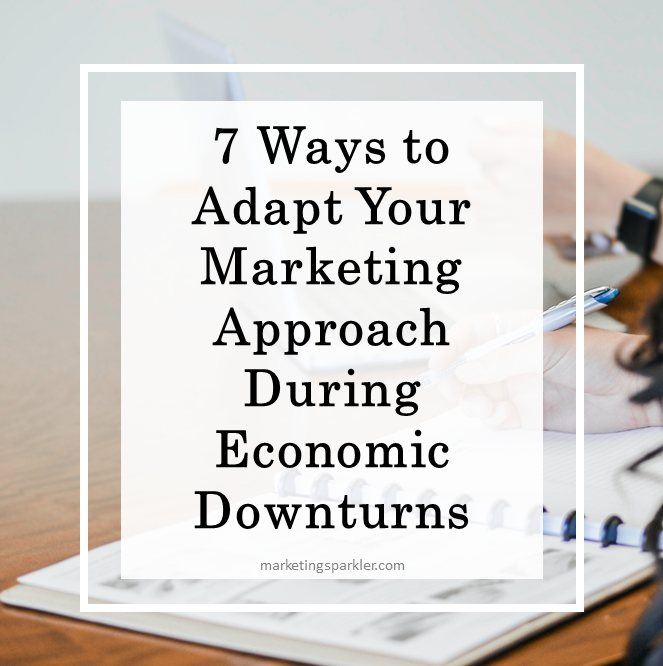Small-business owners often struggle to keep their companies profitable during economic downturns. Those with a savvy marketing approach are likely to remain afloat and even gain market share. It all starts with understanding the differences between marketing in a recession and at other times.
Fortunately, adapting your marketing approach doesn’t have to take a lot of time or money. Making a few simple changes keeps revenue coming in even while brands around you shut their doors. Here are some ways to adapt your marketing approach and find success in any economy.
7 Ways to Adapt Your Marketing Approach During Economic Downturns
1. Turn to Less Expensive Marketing Methods
Statista reports the amount spent on digital advertising in 2023 is $679.8 billion globally. By 2027, 69% of total ad spend will be via mobile. One of the reasons for the rising popularity of digital marketing is a lower upfront cost and higher return on investment (ROI). Digital marketing enables you to better track results and lose the things that don’t work.
It makes sense to turn to less expensive methods in a tightened economic environment. Reach more people for less money and convert them into customers. If you’re bringing in less revenue, you might also reduce your budget. Digital advertising allows you to continue marketing in a recession. The cost is less than many traditional methods, so even if you’re spending less, you can still ramp up promotional efforts.
Digital marketing is a lower upfront cost and higher return on investment (ROI) than traditional marketing. Digital marketing enables you to better track results and lose the things that don’t work. Click To Tweet2. Survey Your Audience
Most companies waste at least some of their budget on ads that don’t work. Track results carefully to ensure you’re spending every penny wisely. Survey your target audience to ascertain their immediate needs.
For example, if you sell clothing, people might be willing to buy new socks but not the latest fashion trend. Once you understand your audience’s needs, you can shift your focus to offers they’ll respond to. Conduct split tests to see what they respond to and what converts to sales.
Another thing to consider is adding a new target audience. Not everyone will be impacted by the recession. Seek customers who want what you sell and still have plenty of disposable income. Perhaps you’ve wanted to expand your audience for a while. Now is the time to do so.
3. Reassess Prices
Are you charging too much? If people tighten their belts, they may cut anything over a certain amount that isn’t a necessity. One way to keep revenue flowing is by offering special discounts or breaking up packages so people can buy a la carte.
Service-based businesses may find the a la carte method particularly beneficial to keeping and attracting customers during lean times. People can pick and choose only what they most need. It keeps funds coming into your business rather than having shoppers cancel the service completely.
Don’t cut marketing, even if you shift the focus of your promotions. It takes 12-18 months to see the impact of cutting marketing methods during a recession. Don’t lose momentum due to fear.
Did you know? It takes 12-18 months to see the impact of cutting marketing methods during a recession. Don’t cut marketing, even if you shift the focus of your promotions. Click To Tweet4. Push the Unique Value Proposition (UVP)
Marketing in a recession often requires pointing out the UVP of your product or service. People need to feel they are getting the most bang for their buck possible. What about your brand makes you stand out from the competition? What do you offer that no one else does?
Once you figure out your UVP, make a point of listing it in any marketing. People should immediately understand the benefit of choosing you over competitors.
5. Personalize Your Efforts
Direct marketing develops one-on-one relationships with your customers. Consumers are much more likely to stick with a brand that greets them by name and understands what they need. Take the time to dig into your analytics and determine what makes your typical buyer tick.
Create buyer personas and gear all marketing to the mock person. You should also segment your mailing list so each message is highly personalized to the people you’re sending it to. Send only the offers that make sense for each portion of your audience.
6. Keep the Customers You Have
Customer retention is a challenge for most businesses. It’s normal to have some churn, but during economic downturns, you can lose customers in droves. Your marketing can make the difference between keeping loyal shoppers or losing them.
Cable and satellite companies are notorious for offering new subscriber specials and ignoring the loyalty of people who’ve been with them for many years. Many will cancel one and move to another to get better rates and then switch back.
When you advertise an offer, you should have something equally good or better for current clients. Marketing in a recession may cause you to focus on building new leads, but don’t forget your current ones. They can send referrals your way, too. Reward them for their loyalty and watch word-of-mouth marketing take off for you.
It’s normal to have some churn, but during economic downturns, you can lose customers in droves. Your marketing can make the difference between keeping loyal shoppers or losing them. Click To Tweet7. Add Value
Another thing you can do when marketing in a recession is add value to your current offers. People tighten their spending but still want a good deal. If they can get something more or faster or better, they’re much more likely to part with their money than if you keep things the same.
What you offer depends on your industry. For example, if you’re a website service provider, you might add better security software, free migrations, or an extra month on signup or referral.
Look at what you currently offer and how you can add to it without raising prices. What do your customers want? Offer them the things they care most about to keep them and attract new clients.
The best way to market during an economic downturn is to figure out how your customers are reacting to the economy. What are their priorities, and how can you help? Click To TweetMarketing in a Recession
The best way to market during an economic downturn is to figure out how your customers are reacting to the economy. What are their priorities, and how can you help? You might not be able to fix the cost of groceries or the going rate for a barrel of gas, but you can control the products you sell and how you package them. You also can manage your marketing efforts and reach your audience with the message they most need to hear during lean times.
Ciao,
Miss Kemya


